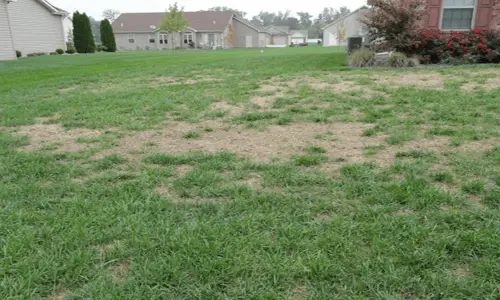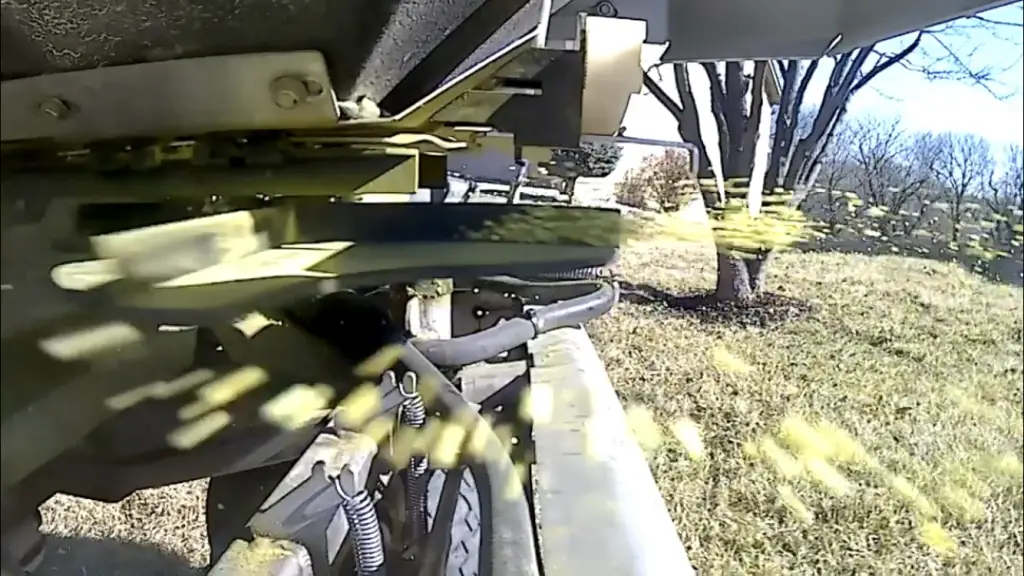First Application: Early Spring
Your lawn fertilizer schedule should begin with an application in March or April. In Michigan, its important to get the first fertilizer application down after the first frost is gone from the ground, but also before the soil temperature gets too warm and weed seeds begin to germinate. Infusing soil and root systems with nutrients helps your lawn recover from its dormancy in the winter and bounce back to good health.
San Antonio Lawn Fertilization Schedule
- Late March Late April For Spring Lawn Fertilization:;Grass must be actively growing to absorb fertilizer properly. After the second mowing of the season, apply a simple 19-5-9 formula for an early green-up. Rainbow Gardens 19-5-9 premium lawn fertilizer is specially formulated for our region.
- Mid May Early August For Summer Lawn Fertilization : Apply slow-release 3-1-2 or 3-0-2 fertilizers or a liquid lawn fertilizer like Medinas Hasta-Gro lawn food.
- ;This is not always necessary, but if turf grass looks yellow and weak you could apply a granular or liquid iron supplement. Every second or third month during the warm season should be enough. Hi-Yield Iron Plus granules and Dr. Iron are two excellent choices. Stay away from Ironiteit doesnt have much effect in our alkaline soils.
- ; Apply winterizing formulas for winter hardiness. Ratios vary, but make sure they are winter or fall formulas designed for southern grasses. Rainbow Gardens 18-6-12 winterizer formula is a great choice These formulas will make lawns winter-hardy and provide for early spring green up.;4-6 weeks earlier for fall organic lawn fertilizer.
*Try your best when applying fertilizers to keep it on the turf as much as you can. Avoid over-spreading onto sidewalks, driveways and streets, as this leads to run off. Fertilizers with iron can stain concrete. Nitrogen and phosphorous are great for the lawn but not for our water supply.
How Much To Fertilize
Apply between 2 and 3 pounds of nitrogen per 1,000 square feet each year during the growing season. If you dont use Total Lawn Food, be sure to check to ensure the fertilizer is approved for use on Bermuda, Zoysia or Fescue. Look up our exact fertilizer recommendations per grass in our Lawn Maintenance Guides.
To do the math on specific fertilizer rates for your lawn, visit our blog post on How to Calculate Fertilizer Rates.
Follow the schedules below to ensure youre fertilizing during the appropriate months of growing season.;;
Don’t Miss: How To Test Lawn Soil Ph Level
What Fertilizer Do You Put Down In The Spring
In the spring, apply a 20-5-10 fertilizer mix. Be careful not to apply to early as fertilizer can easily burn vulnerable grass. Keep in mind that there are other things you can do before its time to fertilize. In late May or early June, before the heat of the summer arrives, apply some slow release nitrogen.
How Do I Know If My Lawn Needs Fertilizer

A phosphorous deficiency will turn grass a dull, blue-green color in its early stages, and then in the later stages will turn the edges of the blades a purple hue. Eventually, the grass will look reddish. This signals a need for phosphorous-heavy fertilizer, including heat-dried or aged poultry and cow manure.
You May Like: How Often Should I Water My Lawn In Colorado
Second Application: Late Spring
Performed in May, the second lawn fertilizer application is intended to make sure your lawn has the nutrients it needs to thrive during what is a very active part of its growing season. Because this is an active growing period for weeds as well, the second application should include a liquid blanket weed control to remove any newly germinated weeds.
Applying A Summer Insect Control
A more common problem you will see in the summer months are insects.
If you see insects in your grass, use a feeding product that also contains insect control, such as Scotts Turf Builder with SummerGuard. It contains;0.086% Bifenthrin.;Bifenthrin is a pyrethroid insecticide.
It will help control ants, armyworms, billbugs, chiggers, chinch bugs, crickets, fleas, grasshoppers, mole crickets, mealy bugs, sod webworms,; lawn moth larvae, spiders, ticks and weevils.
Pyrethroids are synthetic compounds made to act like the natural organic pyrethrins that are; found in chrysanthemum flowers. Pyrethrin is used against a wide range of insects including ants, beetles, Colorado potato beetle, and Mexican bean beetle, cabbage loopers, caterpillars, fruit flies, leafhoppers, mosquitoes, ticks, whiteflies, & more.
For additional insect control try Ortho Bug B Gon granules or liquid around the perimeter of your home. Both contain Bifenthrin.;For flying insects like mosquitoes and flies, I recommend Cutter or Deep Woods Off products.
Or try citronella plants or Tiki torches with citronella.; One candle probably wont make much of a difference, but several citronella candles burning nearby keeps people safe from the pests when sitting, enjoying a picnic, or just being outdoors or in the garden.
For summer lawn care, I focus on maintaining my lawn. Remember, early spring is when you should apply weed and feed if you are trying to control many summer weeds.
Don’t Miss: What Can I Spray On My Lawn To Kill Gnats
Best Time To Fertilize Your Lawn
Spring means more daylight and warmer temperatures. After a cold winter, this is the weather your grass is craving. If youre unsure of exactly when to lay down your first feeding, you can base it off of the temperature. Ideally, the ground should be around 55 degrees Fahrenheit. Depending on where you live, March to April is the best time to fertilize your lawn. Its also best if your yard is watered a few days before you want to apply the fertilizer, whether thats from rain or a sprinkler.
Fertilizer provides your grass with extra nutrients that help to prevent crabgrass and allow it to grow green and thick. To ensure youre laying the feed correctly, start around the perimeter of your lawn. Then, you can start filling in the middle. Similar to mowing your yard, you should go back and forth in straight lines. And you should always use a lawn spreader instead of your hands to complete the job.
Now that you know that spring is the best time to fertilize your lawn, here are some other helpful tips that will keep your grass thriving.
Bermuda Zoysia & Centipede
Early Spring
Omit fertilizer for these months. Your grass will be dormant, and you dont want to promote growth during this time.
Pre-emergent exception: You may apply a low nitrogen fertilizer and pre-emergent combo from late February to early March to prevent weed seeds from germinating. An example of a low nitrogen ratio is 0-0-7 with pre-emergent.
Limestone: During early spring, conduct a soil test to determine if the pH of your soil is too acidic. If the results of your soil test pH are too low, apply lime to your lawn. We recommend Pelletized Dolomitic Limestone.;
Spring
When all of your grass is green and completely out of dormancy, apply 16-4-8 + Iron to Bermudagrass and Zoysiagrass.
Since Centipedegrass likes low nitrogen, apply 5-10-30 + Iron to it. Centipede fertility is a little different than other lawns so read our Fertilizer Tricks for your Centipede Lawn.
Organic Lawn Care Alternative: Instead of applying fertilizer, topdress your lawn with Soil3 organic humus compost. This will act as one application of fertilizer for the year and cut down on your chemical use.
Mid- Summer
Apply 16-4-8 + Iron as your final application of fertilizer for the year.;
Fall and Winter:
Read Also: How To Restore Grass Lawn
Third Application: Early Summer
Next up on the lawn fertilizer schedule is a June application. In preparation for the seasonal shift, the addition of nutrients in this application helps prepare your lawn for the summer and set the stage for healthy growth throughout the season. Liquid weed control should be utilized here as well to treat any weeds that remain on your lawn.
Is It Ok To Fertilize In November
Winter fertilizers are usually applied in late October or early to cool-season lawns. To take full advantage of the effects of winterizer fertilizer, you should also apply fertilizer to your lawn in early September. The early fall feeding stimulates root growth.
You may ask, What should I put on my lawn in November?
Most lawns require 4 pounds of nitrogen per 1,000 square feet per year. The fertilizer application is in four equal sessions of 1 pound of nitrogen. The last month to fertilize cool-season grasses is in , preferable within the first week.
Read Also: When Does Lawn Mowing Simulator Come Out
Is It Ok To Fertilize Lawn In July
fertilizingfertilizerlawnfertilizelawns
Yes!I typically use this type of fertilizer in a fall or late spring time frame. I typically do not recommend this type of application during the summer, because the temperatures in the midwest, are in the 90’s and the ground is usually very dry. Cool temperatures a wet May- time frame.
Beside above, what fertilizer do you put down in July? Try a slow-release fertilizer with reduced Nitrogen, but make sure your lawn is moist 1/2inch down.
Similarly, it is asked, is it too late to fertilize my lawn in July?
Fertilizing only in the spring or the summer will deprive your lawn of the extended benefits of fall fertilization. During the summer the grass plant produces energy from photosynthesis that it uses for top growth. As temperatures drop in the fall root growth is favored over plant growth.
How do I keep my grass green in the summer?
Keeping Your Grass Green during the Summer Months
What Is The Best Fertilizer For St Augustine Grass

To maintain a healthy St. Augustine lawn, choose a complete fertilizer that delivers a high quantity of nitrogen for blade growth, phosphorus for root development, and potassium for disease and cold resistance. This 16-4-8 fertilizer delivers the perfect balance of nutrients without risking nitrogen overload that could damage your lawn.
- 16-4-8 fertilizer is perfectly balanced for St. Augustine lawns.
- Milorganite is a natural, non-burning fertilizer great for use in the summer heat to promote greener St. Augustine.
Because nitrogen fertilizer can burn lawns if applied during temperatures over 90 or during periods of drought, at these times it is beneficial to use a natural, slow-release nitrogen fertilizer, such as Milorganite. In addition to being gentle on lawns, Milorganite contains iron, which encourages your St. Augustine to stay rich green in color.
Read Also: Does Aarons Rent Lawn Mowers
Keeping Up With Fertilizing Schedules
You may love your lawn so much that you print out this blog post and hang it on your fridge. You could even set up reminders in your digital calendar to notify you when its time to fertilize for the season. But if you prefer an easier alternative, sign up for our Monthly Lawn Tips emails. Well send you an email each month with tips on fertilizing, mowing and dealing with pest or disease problems in your lawn.
What Month Should I Fertilize My Lawn
Spring is an important time to fertilise, as your lawn breaks the winter dormancy. Your fertiliser application will assist the lawn to jump into growth as the weather warms up. You need to make sure you dont get too excited and spread it out too early, so timing is key when applying fertiliser in spring.
Read Also: How To Keep Your Lawn Healthy
Is It Better To Fertilize Before Or After Rain
Dont wait too long after a heavy rainfall to apply fertilizer. When the top two inches of soil have dried, the benefit of good distribution of the fertilizer in the root-zone area may be reduced. It is for such reasons that we suggest soil moisture should be at good levels just before a fertilizer application.
When Do You Fertilize Your Lawn In Nj
Spring and fall are the two best times to fertilize your lawn in New Jersey, but the real answer depends on how often youre willing to apply the fertilizer.;
For a thick and healthy lawn, youll want to fertilize a few times throughout the year, with the major times to fertilize being spring and fall. Around mid-April, when the soil temperature reaches around 55 degrees Fahrenheit and the grass is just beginning to grow is the ideal time to do your first round of fertilizer of the season.;
However, if you only plan to fertilize once per year, fall is the best time to fertilize your lawn in NJeven as your turfs growth slows down in the cold, its roots can still take advantage of the fertilizer. Even better, fertilizing in the fall will protect your lawn throughout the winter and make it lush and thriving come spring. Ideally, you should aim to fertilize once in early September, to help your lawn repair the damage done by summer heat, and then again in October or November to fortify your lawn for the winter.;
Its important to know that New Jersey fertilizer laws require that you not apply fertilizers containing phosphorus or high levels of nitrogen between November 15th and March 1st due to the risk of run-off pollution occuring.;
Recommended Reading: How To Treat Rust Fungus On Lawn
Water Deeply But Not Too Often
- Too much watering can lead to poor growing conditions and disease problems.
- Water only when your lawn needs it, usually no more than once a week when there is no rainfall.
- Apply at least 2.5 cm of water. Put a tuna or pet food can on your lawn to measure how much you’ve watered. Stop watering when it’s full.
- Consider the soil type and surface features. Grass growing on compacted, fine soil or on slopes needs lighter, more frequent watering.
Best Fertilizers To Use
The best fertilizers to use are slow release. When you use slow release fertilizers, the grass will get green without growing too quickly. In the spring, mixtures of 20-5-10 are suitable to use. You can also perform a soil pH test before you start the process. Then, you can base the mixture off of your results. For example, if your pH tests come back with high potassium results, you can look for a combination that is lower in that category.
To keep your grass healthy, its best to have a set plan in place for fertilization. The experts at Moyer Indoor | Outdoor are happy to fertilize your lawn this spring so that you can enjoy the outdoors all season long.
Read Also: When To Fertilize Lawn In Iowa
Weed And Feed For Summer: June July August
Can you apply weed and feed in the summer? The short answer is yes. But you must be careful when you apply as summer heat and drought will take its toll on your lawn.
Feeding your lawn, especially in the early summer helps strengthen the lawn so it can better withstand heat and drought conditions that commonly occur. Applying summer weed and feed releases nutrients slowly over time, making it a great fertilizer for all grass types.
A more common problem in the summer is insect control, which I will discuss later in this article
Summer is tough on grass, thanks to heat, drought, foot traffic, and insects. As the warmer temperatures of July and August come around, a much more common problem you will see are insects. Both Scotts and Sta Green have a summer fertilizer with insect control.
Summer Lawn Care Tips

Through June, most weeds continue a very active growth phase. As the summer progresses, this changes. In July and throughout August, most weeds are slowing down or even stopping their growth.; The combination of less water available and light levels dropping back from their June peak will cause weeds to reduce any new growth.
A mixture of weed and feed with 2,4-D, dicamba,; onto leaves can take care of your weed problem.; Weed and feed products for broadleaf weeds are mixed products, though. They also contain nitrogen,; phosphorus, and potassium to promote a healthy lawn.
Also Check: How To Repair Grass Lawn
Do You Fertilize Your Lawn Before Or After Rain
This is not a yes or no situation, but an it depends.;
If you fertilize before rain, you will be spared the task of having to water your lawn to help fertilizer soak in. However, if the rain is heavy enough, you risk your fertilizer being washed away and possibly polluting local waterways. While it is fine to fertilize before a light rain, if you are expecting heavy thunderstorms, it might be best to aim to fertilize your lawn after the rain has passed.
Never Too Late For A Lush Lawn
Never Too Late for a Lush Lawn
No matter how well summer treats you, itll always put your lawn through a bit of a beating with obstacles like dry spells, heat, wildlife infestation and foot traffic. Luckily, the end of summer is an ideal time to breathe new life into a lackluster lawn. So if youre thinking its too late to grow a lush lawn, think again! Youre right on time.
Don’t Miss: How To Make Lawn Grass Green
When Should I Fertilize My Lawn In New Jersey
Is March too early to fertilize my lawn? What is the best fertilizer for New Jersey grass? How often do I fertilize? Why do I need to fertilize my lawn in the first place?;
Lawn fertilizer promotes growth in your grass, which means for a thick, green yard. Its the proper next step after lawn aeration in order to bring your lawn back to health after a cold winter and the harsh summer. While homeowners know lawn fertilization is necessary, that doesnt mean it isnt confusing! To help you figure out the ins and outs of lawn fertilization, the experts at Healthy Lawn compiled everything you need to know about lawn fertilization in New Jersey.
